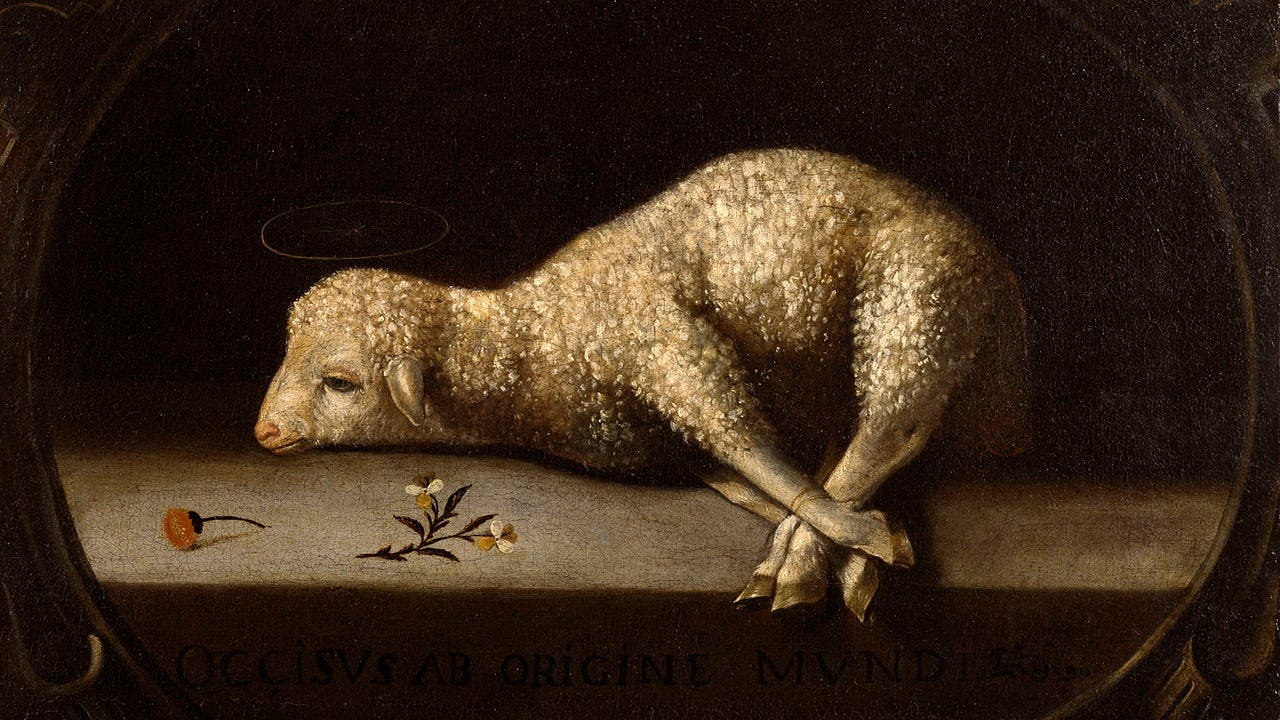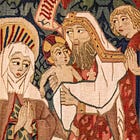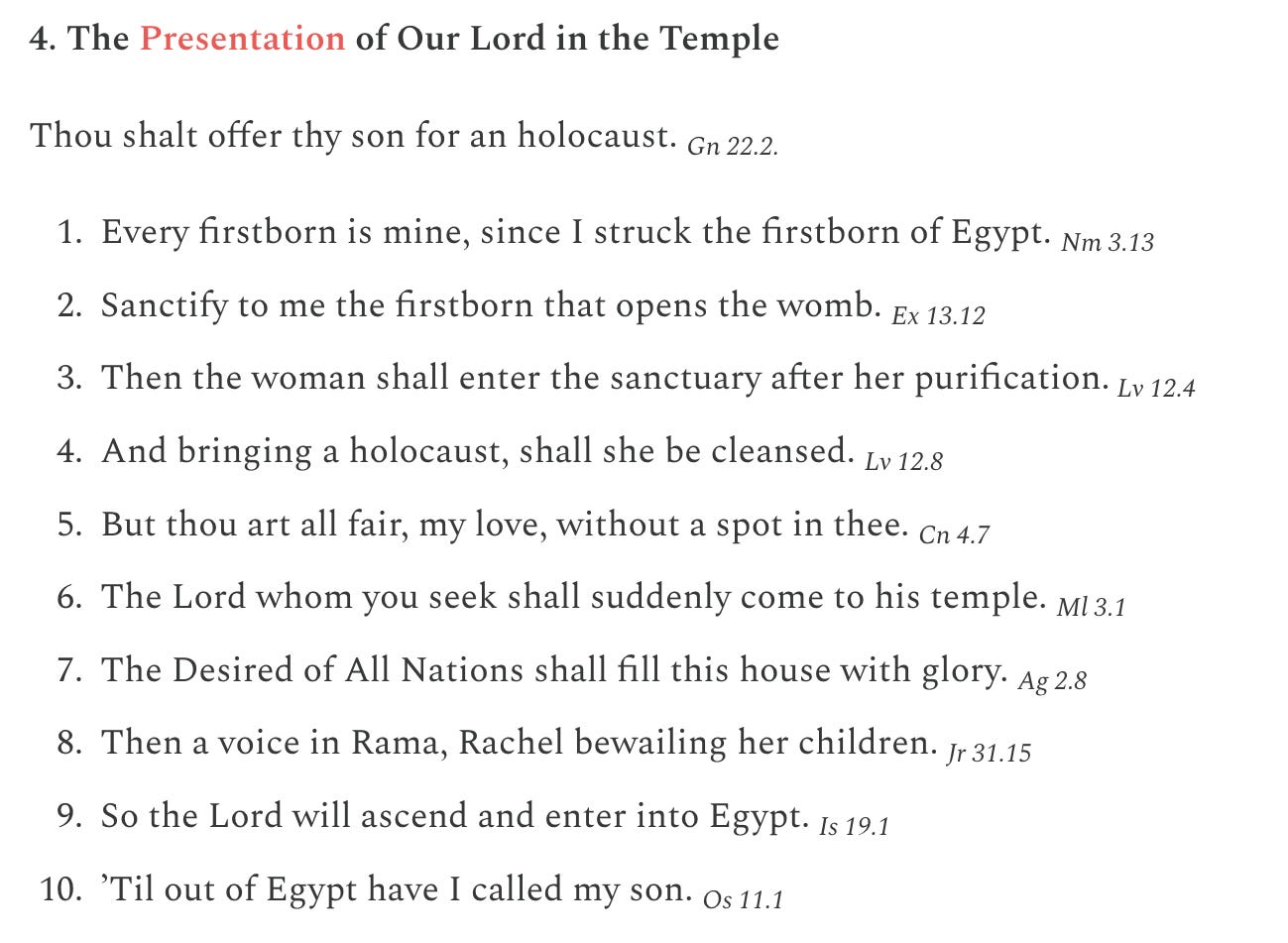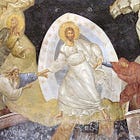How does Candlemas point to the Passover and to the Cross?
It's not just about candles and processions—it's also about sacrificial lambs.

It's not just about candles and processions—it's also about sacrificial lambs.
In this piece, Father Coleridge tells us…
How Our Lady and St Joseph observed the Law of Moses after Christ’s Circumcision, despite its prescriptions not applying to them in the strict sense.
What the law of the redemption (or “buying-back”) of the first-born signified, and how it related to the Passover and Exodus
How Our Lord’s redemption as the first-born was symbolic, prefiguring His role as the Redeemer, and the Passover Lamb whose blood would redeem mankind.
Coleridge shows us that, though Christ was not bound by the Law, he willed to submit to it, both to honour the divine ordinances, to fulfil what they signified, and to point forward to the Redemption.
Editor’s Notes
The law of the first-born
The law of presenting and redeeming the first-born, instituted in memory of Israel’s deliverance from Egypt when the first-born of the Egyptians were slain, finds its highest fulfilment in Him.
God says that since that moment, “Every first-born is mine.” In a sense, this is saying that he has a right to the first-born’s life, as all the first-born of Israel would have been slain by the Angel of Death, had they not been spared through the blood of the Passover lamb.
This is why the first-born was presented at the Temple: as an offering to be sacrificed.

But God did not wish to accept the bloody sacrifice of each first-born. He did accept an unbloody sacrifice of each first-born, in that they all were specially consecrated to him, especially in this moment.
His right to a bloody sacrifice was waived, and he allowed them to be bought back by their parents at the cost of an animal, sacrificed in their place.
This whole picture is pregnant with typology, foreshadowing what was to be achieved in Christ.
Application to Christ
Although not bound by the law, Christ submitted to it in order to unite himself with the human race and the chosen people.
However, the sacrifice of his life would not in fact be waived. Christ was born in order to fulfil what all this meant, and offer his life as a pure and holy sacrifice on the Cross.
He was not merely “redeemed” at the Presentation, as if his life could be bought with animal sacrifice. Instead, this feast commemorated a solemn, liturgical moment in which humanity, in the persons of St Joseph and Our Lady, presented their divine son as a sacrifice to God.
This was the presentation to which all the others pointed. But unlike those others, this presentation and offering was accepted. Blood would be shed—but not yet. In a sense, we could see it as similar to the Offertory of the Mass—this event was the “Offertory of the Passion.”
This is because Our Lord Jesus Christ was the Redeemer himself; he was the true Passover lamb, whose blood would cleanse from sin and turn away death from all who are sprinkled with it.
The Purification
The Thirty Years—Our Lord’s Infancy & Hidden Life
Ch. V, pp 109-121
St. Luke ii. 22-39; Story of the Gospels, § 11
Burns and Oates, London, 1885 (1915 edition).
Headings and some line breaks added.
Sung on the feast of Candlemas
After the Circumcision
After the mystery of the Circumcision of our Lord, the veil again falls over the history of the Holy Family.
The Circumcision had decided the general rule which was to be observed by St. Joseph as to all the obligations and injunctions of the Law. Circumcision was not indeed itself a part of the Law, in the sense that its obligation rested upon the Law. It was the condition of the covenant of God with Abraham, not a fresh enactment made at Mount Sinai.
But it had been ruled, so to say, for many Divine reasons, some of which we have been considering in the last chapter, that the Infant Saviour of the world should be circumcised, although the great reason for which the rite had been instituted had no place in Him.
St. Paul, as has been said, argues in one place that a circumcised man became subject to the obligation of the whole Law.1 It is not necessary here to examine the full meaning of this statement, or the sense in which it is urged by the Apostle. But it was enough for St. Joseph to follow, in the case of the Blessed Mother, the rule which he had followed in the case of her Child. According to that rule, she would have to be purified according to the Law of Moses, framed for all mothers who had borne children in the ordinary way.
Moreover, there was another law which bound her Child, as well as that which applied to herself. For the Law required that every first-born son ‘‘that openeth the womb” of his mother should be redeemed in the Temple. That is, all the first-born belonged by right to God, and a small tax had to be paid as a ransom, or bringing back of such, that they might belong to their parents again.
The regulations, in both these cases, were laid down with great precision in the Law, and St. Joseph could not but be eager to fulfil them.
Law of Purification—and the Redemption of the First-born
“And after the days of her purification, according to the Law of Moses, were accomplished, they carried Him to Jerusalem to present Him to the Lord, as it is written in the Law of the Lord, that every male opening the womb shall be called holy to the Lord, and to offer a sacrifice according as it is written in the Law of the Lord, a pair of turtle doves or two young pigeons.”
Thus, what was obligatory in the case of the Blessed Mother, or rather what would have been obligatory, if she had been like other mothers of the holy people, was that she could not enter the Temple, remaining under the ban of legal impurity for the required number of days, and that then she should present herself at the door, and make the requisite offering, after which the priest was to pray for her, and she was to be considered clean.
What was required in the case of the first-born male child was that it should be redeemed by the payment of the small tax already mentioned. The two rites were naturally connected, and the space of time which was to elapse, according to the Law, before the Purification of the Mother, fixed the date of the Presentation of the Son and His redemption by an offering.
Reasons for these obligations
The grounds on which these two obligations tested were different.
The rules for purification applied to all mothers who had become mothers in the ordinary way, and they formed a part of the system of ceremonial observances which were devised for marking, in the first instance, the natural defilements and physical infirmities, by which childbirth is preceded and accompanied, as things which are more or less connected with original sin, and which require some kind of atonement and purification, before the person in whom they have taken place can be considered altogether clean, fit to enter the Temple of God, and take part in all the worship and devotions of the holy nation.
The period of legal uncleanness lasted for forty days, when the child was male, and for a period twice as long when the child was a girl.
The did not apply in this case
It is needless to say, that all these legal uncleannesses had no foundation at all in the case of the Blessed Mother of our Lord.
She was herself free from the stain of original sin, as of actual sin. She had conceived our Lord by the operation of the Holy Ghost. He had come into the world, leaving her a most pure and perfect Virgin, and the Birth had been altogether most pure and heavenly, utterly free from anything in her or Him in which the reasons for these legal purifications could be found.
So far, then, it might have seemed that there was no occasion for our Lady to be as other women in this respect. The very letter of the Law did not bind her, for the conditions laid down by that letter were not verified in her. It might have seemed as if the Lawgiver himself had had her case in view, and had so arranged the words of the prescription in question as to leave her untouched. Thus neither the reason of the commandment, nor the commandment itself, applied to her.
The law relating to the redemption of the first-born rested on a different foundation [to that of the purification after childbirth]. It was enacted before the Israelites left Egypt, and it was based on the destruction of all the first-born among the Egyptians as a last plague, to force the hard heart of Pharaoh to obedience to the will of God in letting the Israelites depart.
Then, before the people had crossed the Red Sea, and before the final destruction of Pharaoh and his army in its waves, Moses had been commanded to instruct the people on this point.
“When the Lord shall have brought thee into the land of the Chanaanite, as He swore to thee and to thy fathers, and shall give it to thee, thou shalt set apart all that openeth the womb for the Lord, and all that is first brought forth of thy cattle, whatsoever thou shalt have of the male sex, thou shalt consecrate to the Lord. And every first-born of men thou shalt redeem with a price.
“And when thy son shall ask thee to-morrow, ‘What is this?’ thou shalt answer him, ‘With a strong hand did the Lord bring us forth out of the land of Egypt, out of the house of bondage; for when Pharaoh was hardened, and would not let us go, the Lord slew every first-born in the land of Egypt, from the first-born of man to the first-born of beasts, therefore I sacrifice to the Lord all that openeth the womb of the male sex, and all the first-born of my sons I redeem.’”2
Reason for the Law
The Sacred Text goes on to set forth the purpose for which this enactment was made by God.
“It shall be as a sign in thy hand, and as a thing hung between thine eyes, for a remembrance, because the Lord hath brought us forth out of Egypt with a strong hand.”
If the ceremony of the redemption of the first-born had always been accompanied with a lively and grateful recollection of the singular benefits which God had conferred upon His chosen people, it would have been a continual spur to the devotion and faithfulness of the Israelites to His Law.
More than that, it would have reminded them, not only of the deliverance from Egypt, but of the significant circumstances of that deliverance. It would have brought to mind the slaying of the paschal lamb, and the sprinkling of its blood upon the doorposts of the houses in which the Israelites dwelt, that the exterminating angel might pass on, and spare the children within.
Thus the redemption of mankind by the Blood of the Immaculate Lamb of God would have been kept perpetually before the minds of the people, there would have been in every family one at least who might be said to represent the principle of redemption, and when our Lord came to die on the Cross, that feature of God’s rule in dealing with mankind which consisted in the requirement of so ineffable a Sacrifice would have been a sign of the faithfulness of God instead of a stumbling-block to the people.
Not applicable to our Lord and His Mother
Such being the ground of these two precepts of the Law, it is clear that there could be no reason, beyond the simple letter, even if any in that, for the submission to these prescriptions of our Blessed Lady and her Divine Child.
Hers was a child-bearing altogether heavenly and immaculate, and He, as her First-born, needed no redemption to set Him free from the obligation of belonging entirely to God, for He came into the world for the one express purpose of serving God most perfectly from the first moment of His Life to the last, and of setting all the world free from the more than Egyptian bondage of sin.
He was the Redeemer, not the redeemed, He was Himself the Lamb without spot or blemish, by virtue of Whose Blood all were to be saved who were to have any part in salvation.
The first-born of the tribe of Levi were not redeemed by their parents, because they were to be all their lives addicted to the service of God in the Temple and elsewhere. Though our Lord did not belong to the tribe of Levi, still He was the Great High Priest, Himself the Priest and the Sacrifice of the New and Eternal Law. Whatever spiritual blessings and efficacy might be connected with the ministrations of the Levites and priests at the altar, were all derived from Him, and imparted on condition of faith in Him.
Divine reason for its fulfilment
But the Providence of God had ruled that Mary should be purified like other mothers, and that her Son should be redeemed like other first-born, for many Divine reasons. For our Lord always reverenced the laws which His Father had made, even though they were not for Him. He had a special love for the virtue of obedience, by means of which He was to redeem the world, and cancel all the effects of the disobedience of Adam.
It rejoiced His Heart, moreover, to renew in His own Person the grateful acknowledgment of the mercies which had been shown by God to the chosen people, to which He Himself belonged after the flesh. And much more was He continually rejoicing over and thanking God for the spiritual redemption and deliverance of which that old history was a figure, and which He was Himself to accomplish.
Our Blessed Lady, moreover, could rejoice to be as other women in respect of her Purification, in which something of the healing power of the Precious Blood was applied in the sacrifice offered, and in which great homage and a humble acknowledgment of perfect dependence and subjection were offered to God. As our Lord in His Circumcision took on Himself the position and character of one born in original sin, so it would be a delight to His Mother to wear the same character in her Purification.
Her presence there was thus at once an act of obedience and of humility. She obeyed a law by which she was not bound, and she made profession of a state of legal impurity which did not belong to her. It was such a profession to take her stand at the portal of the Temple, to be admitted only after the sacred rite had been performed, and the like. She showed her love for the sacred precincts, and for the privileges of the chosen people, in presenting herself, while there was also a further profession of poverty and of love of purity in her offering.
Thus every action in this sacred mystery had its holy character. The redemption of our Lord by His Mother was very significant also, because it represented, as we have seen, the effects of the blood of the lamb with which the doorposts of the Israelites were marked in order to save the children from the sword of the exterminating angel. All that efficacy, was derived from the representation, by means of that blood, of the ransom which was to be paid for our sins on the Cross.
See the next part:
Check out The WM Review’s Old Testament Rosary, which lets you pray the Rosary through the Old Testament:
From Fr Henry James Coleridge, The Thirty Years, Our Lord’s Infancy & Hidden Life, ‘The Epiphany’, published 1885, this edition Burns and Oates, London, 1915, pp 109-121
Here’s why you should subscribe to The Father Coleridge Reader and share with others:
Fr Coleridge provides solid explanations of the entirety of the Gospel
His work is full of doctrine and piety, and is highly credible
He gives a clear trajectory of the life of Christ, its drama and all its stages—increasing our appreciation and admiration for the God-Man.
If more Catholics knew about works like Coleridge’s, then other works based on sentimentality and dubious private revelations would be much less attractive.
But sourcing and curating the texts, cleaning up scans, and editing them for online reading is a labour of love, and takes a lot of time.
Will you lend us a hand and hit subscribe?
Read next:
Follow our projects on Twitter, YouTube and Telegram:
Galat. v. 3
Exodus xiii. 11-15








